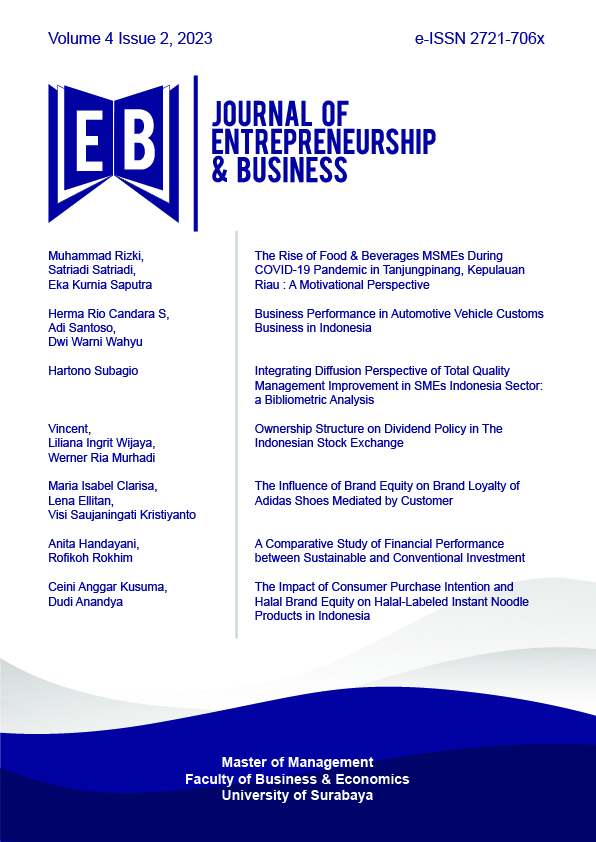The Impact of Consumer Purchase Intention and Halal Brand Equity on Halal-Labeled Instant Noodle Products in Indonesia
 Abstract Views:
1080 times
Abstract Views:
1080 times
 PDF Downloads:
678 times
PDF Downloads:
678 times
Abstract
Purpose: This research aims to examine the impact of consumer purchase intention and halal brand equity from a halal perspective, namely halal brand image, halal brand perceived quality, halal brand satisfaction, halal brand trust, and halal brand loyalty.
Method: This research employs an online questionnaire to collect data from 210 respondents aged 17 and above who have experience consuming halal-labeled instant noodles in Indonesia. Based on the research objective, it falls under basic research. Based on the research type, it falls under causal research. Based on the research approach, this research is classified as quantitative research. Furthermore, this research aims to elaborate on the relationships between halal brand image, halal brand perceived quality, halal brand satisfaction, halal brand trust, halal brand loyalty, purchase intention, and halal brand equity. The theoretical model with hypothesized relationships was developed and tested using the structural equation modeling procedure in SPSS AMOS.
Result: The findings of this research indicate that halal brand image has a significant and positive influence on halal brand perceived quality, halal brand satisfaction, halal brand trust, halal brand loyalty, and purchase intention. Similarly, halal brand perceived quality, halal brand satisfaction, halal brand trust, and halal brand loyalty have a significant and positive influence on purchase intention. Furthermore, halal brand satisfaction significantly and positively influences halal brand equity, but the relationship between halal brand trust and halal brand equity could not be established.
Downloads
References
Aaker, D. A. (1992). The Value of Brand Equity. Journal of Business Strategy, 13(4), 27–32. https://doi.org/10.1108/eb039503
Aaker, D. A. (2012). Book Review: David A. Aaker, Building Strong Brands. Asia-Pacific Journal of Management Research and Innovation, 8(3), 362–364. https://doi.org/10.1177/2319510x1200800317
Agmeka, F., Wathoni, R. N., & Santoso, A. S. (2019). The influence of discount framing towards brand reputation and brand image on purchase intention and actual behaviour in e-commerce. Procedia Computer Science, 161, 851–858. https://doi.org/10.1016/j.procs.2019.11.192
Ahmed, W., Najmi, A., Faizan, H. M., & Ahmed, S. (2019). Consumer behaviour towards willingness to pay for Halal products: An assessment of demand for Halal certification in a Muslim country. British Food Journal, 121(2), 492–504. https://doi.org/10.1108/BFJ-02-2018-0085
Al Mehrzi, N., & Singh, S. K. (2016). Competing through employee engagement: a proposed framework. International Journal of Productivity and Performance Management, 65(6), 831–843. https://doi.org/10.1108/IJPPM-02-2016-0037
Ali, A., Sherwani, M., Ali, A., Ali, Z., & Sherwani, M. (2020). Investigating the antecedents of halal brand product purchase intention: an empirical investigation. Journal of Islamic Marketing, 12(7), 1339–1362. https://doi.org/10.1108/JIMA-03-2019-0063
Ali, A., Xiaoling, G., Sherwani, M., & Ali, A. (2018). Antecedents of consumers’ Halal brand purchase intention: an integrated approach. Management Decision, 56(4), 715–735. https://doi.org/10.1108/MD-11-2016-0785
Atulkar, S. (2020). Brand trust and brand loyalty in mall shoppers. Marketing Intelligence and Planning, 38(5), 559–572. https://doi.org/10.1108/MIP-02-2019-0095
Bhattacharya, S., Sharma, R. P., & Gupta, A. (2022). Does e-retailer’s country of origin influence consumer privacy, trust and purchase intention? Journal of Consumer Marketing, April 2021. https://doi.org/10.1108/JCM-04-2021-4611
Bian, X., & Moutinho, L. (2011). The role of brand image, product involvement, and knowledge in explaining consumer purchase behaviour of counterfeits: Direct and indirect effects. European Journal of Marketing, 45(1), 191–216. https://doi.org/10.1108/03090561111095658
Blackston, M. (2005). Journal of Advertising Research. 45.2. December 2000, 101–105. https://elibrary.ru/item.asp?id=1589644
Boulding, W., Kalra, A., Staelin, R., & Zeithaml, V. A. (1993). A Dynamic Process Model of Service Quality: From Expectations to Behavioral Intentions. Journal of Marketing Research, 30(1), 7. https://doi.org/10.2307/3172510
Chae, H., Kim, S., Lee, J., & Park, K. (2020). Impact of product characteristics of limited edition shoes on perceived value, brand trust, and purchase intention; focused on the scarcity message frequency. Journal of Business Research, 120(November 2018), 398–406. https://doi.org/10.1016/j.jbusres.2019.11.040
Chaudhuri, A. (2002). How brand reputation affects the advertising-brand equity link. Journal of Advertising Research, 42(03), 33–34.
Chen, Y. S. (2010). The drivers of green brand equity: Green brand image, green satisfaction, and green trust. Journal of Business Ethics, 93(2), 307–319. https://doi.org/10.1007/s10551-009-0223-9
Chien-hsiung, L. (2011). A study on the relations between the brand image and customer satisfaction in catering businesses. 5(18), 7732–7739.
Cretu, A. E., & Brodie, R. J. (2007). The influence of brand image and company reputation where manufacturers market to small firms: A customer value perspective. Industrial Marketing Management, 36(2), 230–240. https://doi.org/10.1016/j.indmarman.2005.08.013
Delgado-Ballester, E., & Munuera-Alemán, J. L. (2005). Does brand trust matter to brand equity? Journal of Product and Brand Management, 14(3), 187–196. https://doi.org/10.1108/10610420510601058
Efrizal, W. (2020). Perilaku Konsumsi Mie Instan Pada Remaja di Bangka Belitung. Citra Delima : Jurnal Ilmiah STIKES Citra Delima Bangka Belitung, 4(2), 21–27. https://doi.org/10.33862/citradelima.v4i2.119
Eggert, A., & Ulaga, W. (2002). Customer perceived value: A substitute for satisfaction in business markets? Journal of Business & Industrial Marketing, 17(2–3), 107–118. https://doi.org/10.1108/08858620210419754
Fachrurazi, Silalahi, S. A. F., Hariyadi, & Fahham, A. M. (2022). Building halal industry in Indonesia: the role of electronic word of mouth to strengthen the halal brand image. Journal of Islamic Marketing. https://doi.org/10.1108/JIMA-09-2021-0289
Gkouna, O., Tsekouropoulos, G., Theocharis, D., Hoxha, G., & Gounas, A. (2022). The impact of family business brand trust and crisis management practices on customer purchase intention during Covid-19. Journal of Family Business Management, July. https://doi.org/10.1108/JFBM-03-2022-0046
Gulzar, A., Anwar, A., Sohail, F. Bin, & Akram, S. N. (2011). Impact of brand image, trust, and affect on consumer brand extension attitude: The mediating role of brand loyalty impact of brand image, trust and affect on consumer brand extension attitude: the mediating role of brand loyalty. International Journal of Economics and Management Sciences, 1(5), 73–79. www.managementjournals.org
Ha, H., & Perks, H. (2005). Hong-Youl Ha. Journal of Consumer Behaviour Vol., 4(6), 438–452.
Idris, N. A., Jamaludin, M. A., Hazahari, N. Y., & Muflih, B. K. (2020). Factors Influencing of Malaysian Muslim Women Consumers in Choosing Non-Certified Halal Foreign Brand Makeup Products in Mid Valley Megamall Kuala Lumpur. Journal of Halal Industry & Services, 3(1), 1–13. https://doi.org/10.36877/jhis.a0000117
Jamal, A., & Goode, M. M. h. (2001). Consumers and brands: A study of the impact of self-image congruence on brand preference and satisfaction. Marketing Intelligence & Planning, 19(7), 482–492. https://doi.org/10.1108/02634500110408286
Jani, D., & Han, H. (2014). Personality, satisfaction, image, ambience, and loyalty: Testing their relationships in the hotel industry. International Journal of Hospitality Management, 37, 11–20. https://doi.org/10.1016/j.ijhm.2013.10.007
Karataş, M., & Sandikci, Ö. (2013). Religious communities and the marketplace: Learning and performing consumption in an Islamic network. Marketing Theory, 13(4), 465–484. https://doi.org/10.1177/1470593113499697
Keller, K. L. (1993). Conceptualizing, measuring, and managing customer-based brand equity. Journal of Marketing, 57(1), 1–22. https://doi.org/10.1016/0039-9140(72)80130-9
Keller, K. L., & Lehmann, D. R. (2006). Brands and branding: research findings and future priorities. Marketing Science, 25(6), 740–759.
Khan, M. A., Hashim, S. Bin, Iqbal, A., Bhutto, M. Y., & Mustafa, G. (2022). Antecedents of halal brand equity: a study of halal food sector of Malaysia. Journal of Islamic Marketing, 13(9), 1858–1871. https://doi.org/10.1108/JIMA-01-2021-0012
Khan, N., Rahmani, S. H. R., Hoe, H. Y., & Chen, T. B. (2014). Causal Relationships among Dimensions of Consumer-Based Brand Equity and Purchase Intention: Fashion Industry. International Journal of Business and Management, 10(1), 172–181. https://doi.org/10.5539/ijbm.v10n1p172
Kuang Chi, H., Ren Yeh, H., & Ting Yang, Y. (2009). The Impact of Brand Awareness on Consumer Purchase Intention: The Mediating Effect of Perceived Quality and Brand Loyalty. The Journal of International Management Studies, 4(1), 135–144. h
Kusnandar, A., & Afiff, A. Z. (2020). The Role of The Country’s Image and Halal Branding Constructs in Influencing Repurchase Intentions. European Journal of Molecular and Clinical Medicine, 7(1), 3995–4009.
Kwan Soo Shin, S., Amenuvor, F. E., Basilisco, R., & Owusu-Antwi, K. (2019). Brand Trust and Brand Loyalty: A Moderation and Mediation Perspective. Current Journal of Applied Science and Technology, November, 1–17. https://doi.org/10.9734/cjast/2019/v38i430376
Lee, J. E., Goh, M. L., & Mohd Noor, M. N. Bin. (2019). Understanding purchase intention of university students towards skin care products. PSU Research Review, 3(3), 161–178. https://doi.org/10.1108/prr-11-2018-0031
Malik, M.E., Ghafoor, M.M., Hafiz, K.I., Riaz, U., Hassan, N.U., Mustafa, M. and Shahbaz, S. (2013). Importance of brand awareness and brand loyalty in assessing purchase intentions of consumer. International Journal of Business and Social Science, 4(5), 167–171.
Martínez, P., Pérez, A., & del Bosque, I. R. (2014). CSR influence on hotel brand image and loyalty. Academia Revista Latinoamericana de Administracion, 27(2), 267–283. https://doi.org/10.1108/ARLA-12-2013-0190
Muhsin, M. (2019). Mapping Awareness of Halal Cosmetics Brands in the Teenagers Segment of Bandung City. International Journal of Nusantara Islam, 7(1), 18–33. https://doi.org/10.15575/ijni.v7i1.4874
Oliver, R. L. (1980). A cognitive model of the antecedents and consequences of satisfaction decisions. Journal of Marketing Research, 17(4), 460–469.
Parasuraman, A., Zeithaml, V., & Berry, L. (1996). The behavioral consequences of service quality. Journal of Marketing, 60(02), 31–46.
Pavlou, P. A., Liang, H., & Xue., Y. (2007). Understanding and Mitigating Understanding Online Exchange Relationships : Agent Perspective1 A Principal. MIS Quarterly, 31(1), 105–136.
Roozy, E., Arastoo, M. A., & Vazifehdust, H. (2014). Effect of Brand Equity on Consumer Purchase Intention. Indian J.Sci.Res, 6(1), 212–217.
Savitri, I. A. P. D., & Wardana, I. M. (2018). Pengaruh Citra Merek, Kualitas Produk Dan Persepsi Harga Terhadap Kepuasan Dan Niat Beli Ulang. E-Jurnal Manajemen Universitas Udayana, 7(10), 5748. https://doi.org/10.24843/ejmunud.2018.v07.i10.p19
Šerić, M., & Gil-Saura, I. (2019). Understanding brand equity in hotel firms. What is the role of brand loyalty and satisfaction? International Journal of Contemporary Hospitality Management, 31(9), 3526–3546. https://doi.org/10.1108/IJCHM-06-2018-0516
Sirdeshmukh, D., Singh, J., & Sabol, B. (2002). Consumer trust, value, and loyalty in relational exchanges. Journal of Marketing, 66(1), 15–37. https://doi.org/10.1509/jmkg.66.1.15.18449
T. Yu-Te, W. Chin-Mei, C. H.-C. (2012). Corporate Brand Image and Customer Satisfaction on Loyalty: An Empirical Study of Starbucks Coffee in Taiwan. Journal of Social and Development Sciences, 3(1), 24–32. https://doi.org/10.22610/jsds.v3i1.682
Torres, A., & Tribó, J. A. (2011). Customer satisfaction and brand equity. Journal of Business Research, 64(10), 1089–1096. https://doi.org/10.1016/j.jbusres.2010.12.001
Tsiotsou, R. (2006). The role of perceived product quality and overall satisfaction on purchase intentions. International Journal of Consumer Studies, 30(2), 207–217. https://doi.org/10.1111/j.1470-6431.2005.00477.x
U. Ahmed, Z., Sam Al-Kwifi, O., Saiti, B., & Bin Othman, N. (2014). Consumer behavior dynamics of Chinese minorities. Journal of Technology Management in China, 9(1), 6–23. https://doi.org/10.1108/jtmc-10-2013-0038
Watanabe, E. A. de M., Torres, C. V., & Alfinito, S. (2019). The impact of culture, evaluation of store image and satisfaction on purchase intention at supermarkets. Revista de Gestao, 26(3), 256–273. https://doi.org/10.1108/REGE-12-2017-0009

This work is licensed under a Creative Commons Attribution 4.0 International License.
Articles published in Journal of Entrepreneurship & Business are licensed under a Creative Commons Attribution 4.0 International (CC BY) license. You are free to copy, transform, or redistribute articles for any lawful purpose in any medium, provided you give appropriate credit to the original author(s) and the journal, link to the license, and indicate if changes were made.
Authors submitting to this journal agree to make their work freely available under the CC BY 4.0 license, ensuring broad dissemination and reuse. The full license details can be accessed at https://creativecommons.org/licenses/by/4.0/.
This ensures that they receive the maximum dissemination because there are no barriers to access. This license allows readers to disseminate and reuse the paper, but always requires them to grant the authors and the first publication full credit.
While JEB upholds ethical publishing standards, the responsibility for ensuring originality and compliance with copyright regulations lies with the authors. The journal is not liable for any legal claims related to the content of published articles.
For further inquiries, please contact the editorial team.

 DOI:
DOI:











